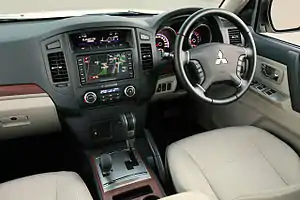Super Select
Super Select is the brand name of a four-wheel drive system produced by Mitsubishi Motors, used worldwide except for North America, where it was initially known as Active-Trac. It was first introduced in 1991 with the then-new second generation of the Mitsubishi Pajero.[1]

The system offers a choice of four rear- or four-wheel driving modes, selected using a lever mounted alongside the gear shift, and can be changed while the vehicle is in motion.[2] In 2H mode the front axle is disconnected and the vehicle is rear-wheel drive. Reduced frictional losses in the drivetrain mean that fuel economy improves while noise levels are reduced.[2] 4H is a full-time four-wheel drive mode using a viscous coupling unit (VCU) and center differential to direct drive to the front wheels when the rear axle loses traction, and is capable of handling a wide variety of road conditions and speeds, (Note: The 4H mode can be used all the time without the common drivetrain 'binding' associated with other traditional 4wd modes).[3] 4HLc is a part-time four-wheel drive mode that locks the center differential to provide extra traction for sandy, snowy or poorly surfaced roads in "high range" mode, while 4LLc, the "low range" mode, also offers a much lower gearing, providing the maximum amount of traction. Changing between 4HLc and 4LLc is only possible with the vehicle stationary (Note: 4HLc and 4LLc are your more traditional four-wheel drive modes, and should never be used on high traction Road surfaces, as drivetrain 'binding' damage will occur).[3]
The system is used on Mitsubishi's Pajero iO mini SUV, while its larger Pajero, Challenger, Triton and Delica models use a more complex system dubbed Super Select II (SS4-II). In most respects the two are the same, although the torque-split in SS4-II is 33/67 front/rear, meaning two thirds of the torque is channelled to the rear axle. In Super Select (SS4i) the torque-split is an equal 50/50. SS4-II also offers an option to lock the rear differential, offering greater traction to the rear axle.[3]
References
- "History of Mitsubishi, 1990–1999" Archived 2007-01-18 at the Wayback Machine, Mitsubishi Motors web museum
- "Super Select 4WD II" Archived 2007-09-29 at the Wayback Machine, Mitsubishi Motors website
- "Super Select" Archived 2002-06-02 at the Wayback Machine, Mitsubishi Motors UK website